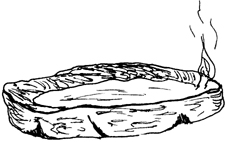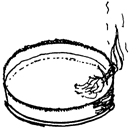Alaska Science Camps, Fairs & Experiments
ANKN is a resource for compiling and exchanging information
related to Alaska Native knowledge systems and ways of knowing. We
are pleased to create and distribute a variety of publications
that assist Native people, government agencies,
educators and the general public in gaining access to the knowledge
base that Alaska Natives have acquired through cumulative experience
over millennia.
TO ORDER THIS PUBLICATION:
Contact the ANKN
offices at 907-474-1902 or email uaf-cxcs@alaska.edu.  Traditional Traditional
Lighting
The long winter months of Alaska make
lighting very important. While recent years have brought electricity
to the villages, many remote cabins and camps still rely on
traditional methods of lighting.
In the Recent Past
We used kerosene lamps, Coleman lamps, and candles for years
before we had electricity.
Traditional Lighting
Upriver people used rendered bear, caribou, and moose fat for
lighting. Coastal people used fish, seal, whale, and walrus oil. In
Southeastern Alaska, the hooligan fish gave so much grease trade
routes were built on its supply,
Whaling boats decimated the Alaska whale population in the late
1800s in order to supply lighting for the East Coast of the United
States. Whole cities were lit by Alaska whale oil.
A simple lamp can be made from a jar lid, a piece of cloth, and
some shortening or vegetable oil.
 There
are three parts to a traditional lamp: the container, the wick and
the fuel. The fuel is from seals, moose, whales, bears, fish, etc.
The lamp itself must be of a material that won't burn such as rock,
clay, sea shells or metal. The wick was traditionally of certain
mosses, but cotton replaced moss long ago. The wick lifts the oil
from the lamp by capillary action and provides a surface for burning
to take place. There
are three parts to a traditional lamp: the container, the wick and
the fuel. The fuel is from seals, moose, whales, bears, fish, etc.
The lamp itself must be of a material that won't burn such as rock,
clay, sea shells or metal. The wick was traditionally of certain
mosses, but cotton replaced moss long ago. The wick lifts the oil
from the lamp by capillary action and provides a surface for burning
to take place.
Container
Traditionally the lamp was of a hollowed stone and sea shells.
More recently, jar lids and metal cans were used.
Make several lamps with different containers. Use jar lids, stone,
metal, aluminum foil, anything you can find that won't burn.
Use shortening for oil and a wick of cotton cloth for now. Soak
the wick in oil before lighting it.
Which materials work best for the container? It takes a bit of
skill to keep the wick properly trimmed. Push it into the oil if it
burns too brightly, and expose it more if it is too dim.
Don't leave the lamp unattended.
Try different materials for wicks. Try the traditional mosses used
in your area. Oil or grease the wick before lighting it the first
time.
Try strips of different kinds of cloth. If the wick has any nylon
in it, it will work the first time, but will not wick the second
time.
Adjust the flame height by moving the wick in or out of the oil.
Which wicks last the longest? Which ones fall apart after several
uses?
Try all kinds of oils: margarine, bear fat, vegetable oil, seal
oil, etc. Do not use volatile fuels like gasoline or Blazo.
They are far too dangerous. Do all experiments on a clean flat
surface that cannot burn, like dirt or concrete. Do not leave lamps
unattended. Sooty flames give headaches after a while.
One time we were stuck with no lights and didn't even have
margarine, so we used 30W motor oil for lamp oil. It gave a decent
light, but the next morning the inside of our noses were completely
black from the soot!
Observe the soot content of the smoke from each oil.
Which oils burn the cleanest? Which burn the longest? Which give
the most light?
To render bear, moose or caribou fat, cut it in very small pieces,
and put it in a pot with a s mall
amount of water. Turn up the heat. Keep the fat from boiling as it is
being rendered. All the water you started with should boil away, or
the grease will sour in time. Pour the rendered grease into a
container as you would bacon fat. mall
amount of water. Turn up the heat. Keep the fat from boiling as it is
being rendered. All the water you started with should boil away, or
the grease will sour in time. Pour the rendered grease into a
container as you would bacon fat.
Rendering can be done with any kind of fat, including fish
oil. We
have done it from the whitefish entrails as they come out of the
lakes in the late fall. They are exceptionally fat at that time.
There are several ways to render seal oil.
Other
Adaptations
Kerosene lanterns evolved from oil lamps. Is there any way you can
make a chimney that causes the oil lamp to burn cleaner, better or
more controlled? Experiment with chimneys of different lengths. A
tomato paste can or coil of aluminum foil might serve for
experimenting purposes.
When you are done experimenting, you should know what containers
and wicks are most efficient and safe. You should know which oils
burn the cleanest, brightest, and longest.
|